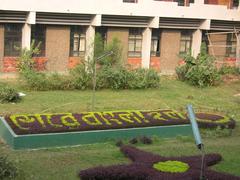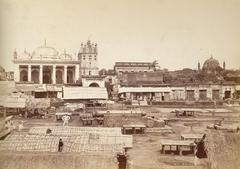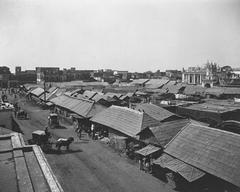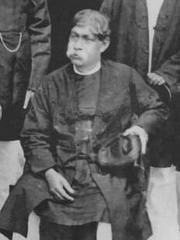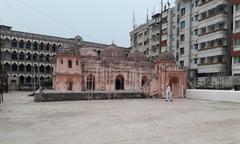Visiting Lalbagh Fort: Tickets, Hours, Historical Insights, and More
Date: 18/08/2024
Introduction
Lalbagh Fort, an architectural marvel from the Mughal era, stands as one of Dhaka’s most iconic landmarks. Nestled in the south-east zone of Bangladesh’s bustling capital, this historical site offers a captivating blend of history, culture, and architectural splendor. Initiated in 1678 A.D. by Mughal Prince Muhammad Azam Shah, the fort was left incomplete due to his abrupt departure to Delhi at the behest of his father, Emperor Aurangzeb (The History Hub). Shaista Khan, the subsequent governor of Bengal, took over the project but halted construction permanently following the tragic death of his daughter, Pari Bibi, casting a shadow of superstition over the site (Atlas Obscura).
Despite its incomplete state, Lalbagh Fort stands as a testament to Mughal architectural brilliance. It includes significant structures such as the Diwan-i-Aam (Hall of Audience), the Quilla Mosque, and the Mausoleum of Pari Bibi, each showcasing a unique blend of Persian, Turkish, and Indian influences (Atlas Obscura).
Lalbagh Fort not only offers a glimpse into the Mughal era’s grand architectural endeavors but also serves as a cultural and historical beacon for Bangladesh. Its gardens, water reservoirs, and fountains add to its charm, attracting numerous visitors year-round. This guide aims to provide comprehensive information on visiting Lalbagh Fort, including its history, visitor tips, nearby attractions, and more.
Table of Contents
- Historical Background and Significance
- Visitor Information
- Preservation and Tourism
- Visitor Experience
- Nighttime Illumination
- FAQ Section
- Conclusion
Historical Background and Significance
Origins and Construction
The construction of Lalbagh Fort began in 1678 A.D. by Mughal Prince Muhammad Azam Shah, the eldest son of Emperor Aurangzeb. Initiated during his tenure as the Viceroy of Bengal, the fort’s construction was halted when he was summoned back to Delhi by his father, leaving it unfinished (The History Hub).
Abandonment and Superstition
Shaista Khan, the next Mughal governor of Bengal, took over the project but did not complete it. The untimely death of his daughter, Pari Bibi, led to the fort’s abandonment, casting a shadow of superstition over it. The incomplete state of Lalbagh Fort has since become a symbol of unfulfilled ambition and historical intrigue (Atlas Obscura).
Architectural Significance
Lalbagh Fort is a testament to Mughal architecture, featuring a blend of Persian, Turkish, and Indian influences. The fort complex includes three main structures: the Diwan-i-Aam, the Quilla Mosque, and the Mausoleum of Pari Bibi. The Diwan-i-Aam, a two-storied building, served as the residence of the Mughal governor and now houses a museum showcasing Mughal artifacts such as coins, paintings, carpets, and weapons (Atlas Obscura).
Underground Tunnels and Mysteries
One of the most intriguing aspects of Lalbagh Fort is its intricate web of underground tunnels. These tunnels were reportedly completed during the fort’s construction and have been the subject of numerous legends and mysteries. During the Sepoy Revolution of 1857, it is said that soldiers from both sides ventured into these tunnels and never resurfaced, adding to the fort’s enigmatic reputation (Atlas Obscura).
Cultural and Historical Impact
Lalbagh Fort holds significant cultural and historical importance for Bangladesh. It serves as a reminder of the Mughal era’s architectural prowess and the historical events that shaped the region. The fort’s incomplete state and the legends surrounding it have made it a focal point for historians, archaeologists, and tourists alike (The History Hub).
Visitor Information
Visiting Hours and Tickets
Lalbagh Fort is open to visitors from 9:00 AM to 5:00 PM, Tuesday to Saturday. The fort is closed on Sundays and public holidays. The ticket prices are around 20 BDT for local visitors and 100 BDT for international tourists.
Travel Tips
Navigating the roads around Old Dhaka can be challenging due to narrow alleys and congested roads. However, the abundance of rickshaws makes it relatively easy for tourists to reach Lalbagh Fort. Once inside, visitors can explore the fort’s various structures, including the Diwan-i-Aam, Quilla Mosque, and the Mausoleum of Pari Bibi (Atlas Obscura).
Nearby Attractions
While visiting Lalbagh Fort, tourists can also explore other historical sites in Dhaka, such as Ahsan Manzil, the Star Mosque, and the Dhakeshwari Temple. These sites offer a deeper understanding of Dhaka’s rich cultural heritage.
Special Events and Guided Tours
Lalbagh Fort occasionally hosts cultural events, historical reenactments, and guided tours. Check the official website or local tourism boards for the latest information on upcoming events and tour schedules.
Photographic Spots
Lalbagh Fort is a photographer’s delight, with numerous spots perfect for capturing its architectural beauty. The gardens, fountains, and white marble of the Mausoleum of Pari Bibi provide stunning backdrops for photos.
Preservation and Tourism
Efforts have been made to preserve Lalbagh Fort and its historical artifacts. The museum within the Diwan-i-Aam houses Mughal miniature paintings, calligraphy, coins, firearms, and swords, providing visitors with a glimpse into the Mughal era’s rich cultural heritage. The fort’s gardens are meticulously maintained, offering a serene environment for visitors to explore and appreciate the historical significance of the site (Atlas Obscura).
Visitor Experience
Lalbagh Fort offers a unique blend of historical intrigue and architectural beauty, making it a must-visit destination for tourists in Dhaka. Exploring the fort’s structures, gardens, and hidden passages provides an enriching experience (Atlas Obscura).
Nighttime Illumination
Lalbagh Fort takes on a mystical aura at night when it is illuminated, creating a captivating visual experience. The fort’s architectural features are accentuated by the lighting, making it a picturesque location for photography and evening strolls. The nighttime illumination adds to the fort’s allure (The History Hub).
FAQ Section
Q: What are the visiting hours for Lalbagh Fort?
A: Lalbagh Fort is open from 9:00 AM to 5:00 PM, Tuesday to Saturday. It is closed on Sundays and public holidays.
Q: How much do Lalbagh Fort tickets cost?
A: Ticket prices are typically 20 BDT for local visitors and 100 BDT for international tourists.
Q: Are there guided tours available at Lalbagh Fort?
A: Yes, guided tours are occasionally available. Check the official website or local tourism boards for the latest information on tour schedules.
Q: What are some nearby attractions to Lalbagh Fort?
A: Nearby attractions include Ahsan Manzil, the Star Mosque, and the Dhakeshwari Temple.
Conclusion
In summary, Lalbagh Fort is a historical gem that offers a unique blend of architectural beauty, cultural significance, and intriguing legends. Its incomplete state and the stories surrounding it make it a fascinating destination for anyone interested in exploring the rich history of Dhaka and the Mughal era. Be sure to visit Lalbagh Fort during its open hours, explore its many features, and take advantage of the guided tours and photographic opportunities.
For more information, follow us on social media or download the Audiala mobile app to stay updated on the latest events and attractions.
References
- The History Hub, 2024, The History Hub thehistoryhub
- Atlas Obscura, 2024, Atlas Obscura atlasobscura
- Travelsetu, 2024, Travelsetu travelsetu
- History Hit, 2024, History Hit historyhit
- Mystic Bengal, 2024, Mystic Bengal mysticbengal
- Goroli, 2024, Goroli goroli





